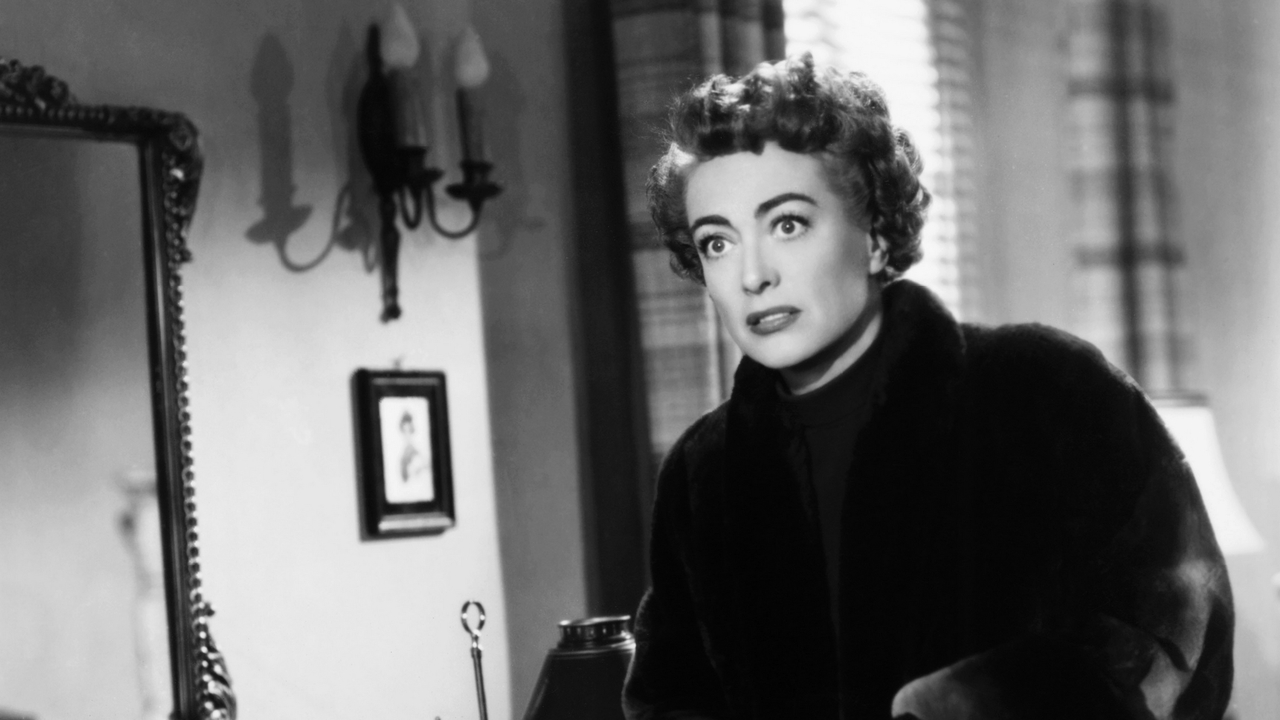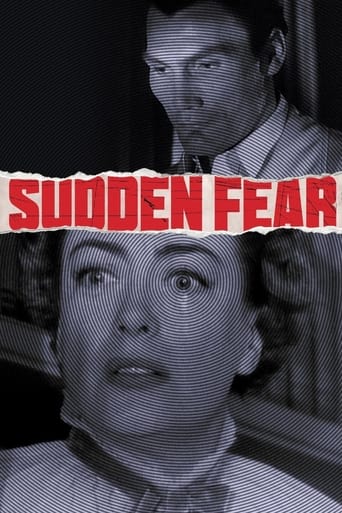

A full-fledged star vehicle for Ms. Crawford, in this film-noir tale, she plays Myra Hudson, a rich Broadway playwright-spinster, who intuitively vetoes an actor Lester Blaine's (Palance) audition for her newest play, since his unusual look doesn't seem to be well qualified for a romantic role, which prompts Lester's chagrin and he rebukes that Myra is wrong for her impetuous decision.Some days later, on the train back to her home in San Francisco after the play turns out to be a hit, Myra encounters Lester, out of courtesy and to manifest there is no hard feelings, they bury the hatchet and Lester proves to her that he in fact is a virtuoso romantic suitor for her despite the age difference, and she is significantly besotted, the two tie the knot afterwards, which erects a perfect hotbed for the ensuing murder plan.There is an ulterior motive in Lester's agenda from his very first move, when his old flame, a sensual siren Irene Neves (Grahame) arrives uninvited, the two scheme together to murder Myra after knowing that the latter will donate the bulk of her fortune to a foundation. But Ms. Crawford will not resign herself to an unwitting wife who is like a lamb to slaughter, right in the midway, Myra receives a rude awakening and unearths Lester's sinister plan, after the initial shock and distress (which inconveniently outstays its welcome as Ms. Crawford's one-woman show), and a clumsy act which accidentally destroys the key testimony, she straightens up and dauntlessly decides to preempt their action in her own way.Here, the movie starts to glisten with suspense, under the ominous chiaroscuro lighting, particularly designated in her favour, Ms. Crawford's dignified mien glints intensely from resolution, hesitation, worry to utter fear, and everything is on tenterhooks, viewers vicariously experience the struggle, strain and danger from Myra's viewpoint, playing meek and unsuspicious in front of her double-faced husband on a daily basis, cautiously plotting her counter-move in the sly step by step, while keeping hold of her usual pretence without arousing any suspicion, she must be a natural actress herself to fake a glamorous fall from staircases without any damage done to undercut her mobility, also a first-rate penmanship-imitator, and practising her first-ever plan of murder in her mind, which is a dead giveaway that things will not proceed exactly in the way as she has envisaged. The biggest question is, is she as good killer as an actress? Is she capable of pulling the trigger when the crunch arrives?The script mercifully (or rather cowardly) saves Myra from being the ultimate executioner of poetic justice, lest it would blemish Crawford's iconic benevolent image, she is never a noir heroine, and here, she is ever so close to be one, an Oscar nomination is quite rewarding, it is the only time, she and her arch-enemy, Ms. Bette Davis (in Stuart Heisler's THE STAR 1952) are competing in the same category, although both are the charming also-rans in this case. An angular, hatched-faced Jack Palance is an unorthodox leading man in his career breakthrough role, who has no qualm in oozing venom while being hospitable and deferential. Yet, he is routinely degraded with a BEST SUPPORTING ACTOR Oscar nomination, high-fives with his fellow nominee Richard Burton in Henry Koster's MY COUSIN RACHEL (1952), an Olivia de Havilland's vehicle, two glaring examples of Academy's category injustice for budding leading actors.One of the strong points of this David Miller's thriller is the cinematography from Charles Lang, greatly taps into the forbidding nighttime of San Francisco, e.g. the final chasing sequences in the steep streets, sufficiently surpasses the ongoing action itself. Finally, a friendly advice to all female viewers, sometimes, you have to stick to your instinct of the first impression, simply because it is a life-saving bonanza bequeathed by nature itself, don't easily throw it away.
... View MoreA slick little thriller from 1952 that showcases Joan Crawford's ability to carry a movie. She starred in a lot of high-quality stuff (like "Mildred Pierce" for example) that any actress would have shined in, but it's when she landed in more middle-of-the-road material that she was able to illustrate her star wattage, because not just any old actress could take a movie like "Sudden Fear" and make something memorable out of it.In this one, Crawford is a playwright and reluctant heiress who decides the actor chosen for the lead in her new drama (Jack Palance, darkly but disturbingly handsome) isn't right after all and has him booted. He meets up with her a few months later and lets her know there are no hard feelings. Indeed, not only aren't there any hard feelings, but the two end up getting married after a whirlwind romance. Only after they're married do we find out that Palance is unsurprisingly a creep and that he and his jilted ex-wife (or current wife, I'm foggy on that point), played with bad-girl relish by Gloria Grahame, have designs on getting their hands on Crawford's dough. Let the plotting begin.The twist in this one is that Crawford finds out about their plan without them knowing, and proves herself to be a sharp cookie in hatching a counter plot to save her skin. It's quite refreshing to see her take matters into her own hands rather than simper and quail waiting for someone else to save her. The ending, a chase through the dark streets of San Francisco, is a bit of a mess, but by then you've had so much fun with the movie and Crawford has won you over with her ballsiness that you don't much care.Crawford received her third and final Academy Award nomination for her performance, and Jack Palance was nominated in the supporting category as well. Perennial Oscar nominee Charles Lang won his 9th of an eventual 18 career nominations for using shadows to make the most out of San Francisco's murky streets and Jack Palance's razor sharp cheekbones. And Sheila O'Brien landed the last of the film's quartet of nominations for designing Crawford's elegant black and white gowns."Sudden Fear" is a treat for film noir lovers, Joan Crawford lovers, San Francisco lovers, suspense thriller lovers, or anyone who just loves a good old fashioned entertaining movie.Grade: A-
... View MoreI liked Sudden Fear but I didn't love it. On the plus side, Joan Crawford is always a force of nature, and this film is no exception; and Jack Palance and Gloria Grahame give good performances as well. The cinematography is good and the use of San Francisco locations adds luster.My trouble is with the script. The first half of the movie drags a bit--almost as if they are trying to lull you to sleep--before they whack you over the head with the first big twist. I love twists in a plot, but they need to be believable and organic to the characters. This one felt contrived, and the character's response to the twists unbelievable. It was like watching three different personalities playing the one part -- with no real explanation for WHY the sudden shifts and turns of personality.
... View MoreThis is The Forth film I saw for Joan Crawford after seeing (What Ever Happened to Baby Jane? 1962 , Mildred Pierce 1945 and Grand Hotel 1932) and to me her best performance was in What Ever Happened to Baby Jane?Now about this film : I don't know what to say, it's not a bad movie and it's not a good one. in the first 45 minutes the film is so boring the film show us a love or to be specific a blind love between an old-woman and a young man played by (Jack Palance) and you know from the beginning that he is a bad guy in these cases when you knew from the beginning the bad guy you become angry unless the film made it in a professional way ,( but not this one) cause Jack Palance face is evil so how could Miss.Crawford loved him I just don't know besides in all of his films he played the bad guy.( so nothing new) the big problem is that Joan Crawford couldn't convince anyone that she was in love with him although she is doing and performing it well she just didn't convince me there isn't a chemistry between these to leading stars. Then after the 45 minutes when she discovered that her lovely husband is a NEMESIS the movie began to get much better and it continuous till the end. but there were many scenes in the second part are funny and made me laugh ( although they didn't suppose to made you feel that way) such as the two imaging scenes they are just not real and when she made herself falling down the stairs if I were her I would probably broke my neck! As for Joan Crawford performance she is doing a good job here especially at the closet scene she did it in a great way and when she see here emotions after looking at herself at the mirror and feeling terrible about becoming a killer that was great one to. if you are Joan Crawford Fan(like me) see this Film , but don't expect too much.
... View More